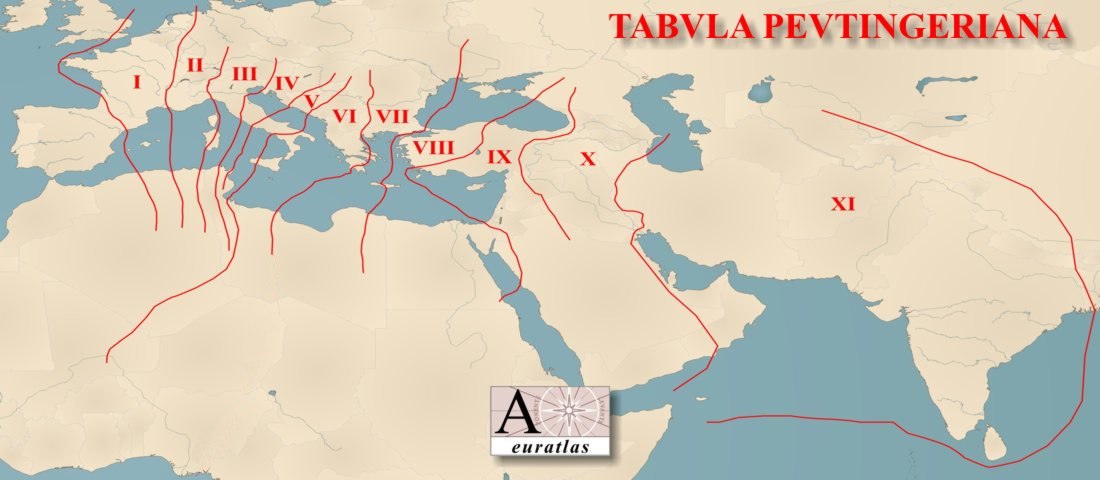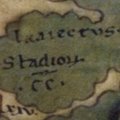| THE COMPLETE TABULA PEUTINGERIANA - a Roman Road Map compared with a modern map |
|
|
|
|
|
|
| Comparison w. |
| Modern Map |
|
|
|
|
|
|
|
|
 |
 |
 |
 |
 |
 |
 |
 |
 |
 |
 |

|
A Very Ancient Document Drawn in 1265 by a monk from Colmar and made up of 11 parchments scrolls measuring approximately 34 cm high by 6,74 m. long when assembled, this document was discovered in 1494 by Konrad Meissel, alias Celtes, and given in 1507 to an Antiquarian of Augsburg, Konrad Peutinger. This document appears to be a planisphere describing the world as it was known in Antiquity. Indeed several disappeared localities, like Pompeii or Herculanum, are indicated and other places, such as Hatra in Iraq or Tegea in Greece, bear their Roman names which were lost during the Middle Ages. In addition, several notes refer to ancient ideas, such as a wide river "flowing" under the Sahara, or Alexander's conquests. Moreover, the localities are connected by roads with distances marked in Roman numerals indicating the miles (1480 m.) or, west of Lyon, the Gallic leagues (2220 m.) |  |
||||||
| Large cities are represented by thumbnails of variable size and a special importance is given to the thermal cities. The metropolises of
this map are Rome, Constantinople and Antiochia. Immediately below the metropolises in size are
Nicomedia (Izmit), Nicaea (Iznik), Aquileia and Ravenna. Ancyra (Ankara) seems to be a town of the same size as Ravenna but its name was not written. The same applies to Alexandria. Moreover, the map seems to indicate some maritime or river ways without clearly marking their departure or arrival destinations. For instance a ferry could exist in the Southern Peloponnese, with a destination of either Crete or Cyrenaica, and Ostia, the harbour of Rome, is positioned exactly opposite Carthage. There is also a reference to a riverway between Ostiglia and the Adriatic Sea or Ravenna. |
 |
||||||
| This leads one to the conclusion that the Peutingerian Table, is the result
of successive copies and overprints carried out at various times from
one or several ancient originals. The oldest information probably goes
back to before 79 AD since Pompeii is indicated. Other temporal
indications can be drawn from Jerusalem which is named Aelia
Capitolina, name given in 132 AD and from Constantinople, the name commonly used since the 5th century for Byzantium. |
 |
||||||
| A Stretched and Flattened Roadmap The reader may be confused with this stretched planisphere on which the Italian peninsula seems to extend from west to east and where Rhodes is close to the area of Tel-Aviv. However, one must realize that this map is a compilation and a positioning of itineraries previously written in the form of catalogues such as the 3rd century Antonine Itinerary. The result is that the whole map looks like a modern subway plan. The routes were drawn in order to be clearly readable without taking into account the scale or of the exact geographical orientation, the essential being to show the distances and the crossroads, not the land topography. |
 |
||||||
| |||||||
| All
of this makes the Table of Peutinger particularly interesting. Indeed,
it
is not a physical and scientific description of the world, as in the
work of Ptolemy, but rather a functional document standing in
comparison with present day roadmaps. The main roads of the imperial
courier service,
or cursus publicus, are shown, making it possible for the
traveller to easily locate the stops, to calculate the distances to be
covered and to organize supplies at the principal thermal places or
water points. It is, therefore an exceptional document without equivalent before the 16th century. What is more, we can imagine that the pilgrims, the merchants or the medieval armies used similar charts in their long travels from the West towards the East. One can try to plan the route from Trier to Rome or from Rome to Jerusalem. Ydrunte (Otranto) is located opposite Scobre (Shkodër) and Dyrratio (Durrës): thus a crossing of the Strait of Otranto is possible there. |
 |
||||||
|
 |
||||||
| Let
us note finally that, contrary to medieval maps, the Table of
Peutinger does not mention fantastic beings, dragons or monstrous
humans. The only non-functional inscriptions refer to known
literary data, for instance: - Grin, un great river flowing under the ground (probably the Niger), - desert where the Children of Israel wandered for 40 years (Sinai), - "here are born elephants" (India), - Sera Major or Land of Silk, that is China, - or "until where Alexander" to mark the end of the world. |
 |
||||||
| The Map Presented Online At present the Tabula Peutingeriana is conserved at the Austrian National Library (Österreichische Nationalbibliothek). With the authorization of this institution, Euratlas is able to present online the 11 original segments of this Roman roadmap. The colors of the images were slightly equalized to increase their legibility, so they can be viewed interactively in real size. It is possible to access each of the 11 sections of this document through either the thumbnails at the top of this page or the modern map above. By clicking directly on the sections, you can enlarge the chosen area. The principal names of places are indicated in their original textual form followed by their usual Latin form and then by their modern name. In addition it is possible to display the same image in black and white simply by clicking on Transcription. With this view certain places are transcribed in red to facilitate their location. The home page for each complete section is designed in such a way that it is possible to display the modern map of the described places by clicking the thumbnail on the bottom left side of the page. Pleae note that, in order to facilitate their reading, segments are designated by the names of the corresponding modern countries. | |||||||
| Our
aim is to offer everyone the possibility to travel firsthand over this
centuries-old document and to make his or her own discoveries.
Therefore we invite you to travel online and dig through this map
of the world
such as it was known in the Roman time. You will discover a multitude
of easily recognizable places. Not all were transcribed in our version
and, if you wish to compare it with a political chart of the Roman
Empire, you can to also refer to the Historical Atlas Euratlas,
available online or by CD-ROM. Christos Nussli, September 2007
| |||||||
Our main source for the transcription of the names and their positioning was the Barrington Atlas of the Greek and Roman World. |
|
||||||